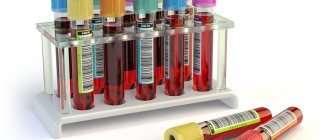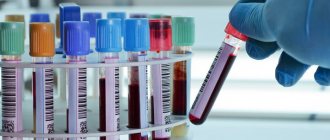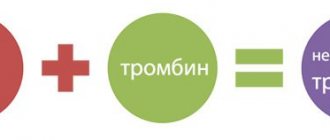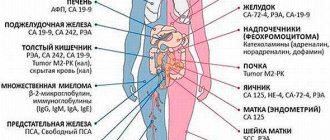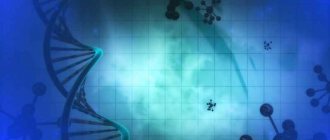Thanks to the development of modern medicine, when making a diagnosis, a doctor no longer needs to focus on indirect manifestations of diseases or conduct multi-stage laboratory tests. It is enough to conduct one analysis that will confirm or refute the alleged initial diagnosis.
This method is enzyme-linked immunosorbent assay (ELISA) - this study allows you to detect specific antibodies and antigens characteristic of various pathologies, which greatly speeds up the diagnosis.
What is ELISA
ELISA analysis is a laboratory test (method) that helps determine the presence or absence of certain antibodies in the body to fight the virus and their quantity.
The basis of the study is the natural reaction antigen (an object harmful to the body) - antibody (a protein that destroys harmful objects), which makes it possible to detect the presence of various viruses and bacteria.
ELISA is a natural immune response of the body - the interaction of an antibody with the corresponding antigen. So, during ELISA, antigens or antibodies are added one by one to a test tube with the material, after which the concentration of the resulting antigen-antibody complexes is determined.
If matches are formed, then immune complexes arise, then an enzymatic reaction of the dye with the combined molecule occurs. It is thanks to the color change during enzymatic indication that the disease is identified after examining the level of the determined compound.
What is the basis of the technique?
The results of ELISA analysis are based on obtaining chemical reactions to enzymes, which serve as special identification marks for recognizing antibodies. Consequently, during immunochemical reactions, antibodies begin to interact with certain antigens. All this gives grounds to assert that false results when donating blood to ELISA are minimal.
The study allows you to determine the number of immune cells, their properties, as well as the presence of the necessary antibodies
The result is considered positive when coloration of the solution is detected. The color indicates that the antigens are interacting with the antibody. If nothing like this happens, the result is negative.
Top article: PCR analysis: what is it and what are its features
Types of immunoglobulins
Human immunoglobulins are differentiated into several classes that differ from each other in the properties, structure and antigenic characteristics of the heavy chains (H chain). All mammals, including humans, have five H-chains, which determine the belonging of immunoglobulins to the corresponding class: G, M, A, D, E.
Each class differs from each other in biological properties, and the ability to bind antigens, and the speed and strength of the connection with the molecule.
The functions of each immunoglobulin (Ig) are different:
| Quantity in the body | Functions | Half-life (days) | Meaning | |
| G | 70% | Form passive immunity in the newborn; necessary for immune response improve phagocytosis, | 21-24 | provide long-term humoral immunity against infectious diseases |
| M | 5-10% | needed to activate phagocytosis, capable of binding 5 antigen molecules, | 5 | Provides the primary immune response |
| A | 10-15 | Neutralizes toxins and viruses needed for the formation of early immunity Formation of local immunity | 4-5 | Protection of mucous membranes |
| E | 0,2% | cause allergies and anaphylaxis activate tissue basophils | 2 | Parasite protection |
| D | 0,2% | involved in the production of lymphocytes, necessary as a membrane receptor for antigens; | 3 | Their role is poorly understood |
The emergence of immunoglobulins occurs along a peculiar “chain” - lgM lgG, this is how the body reacts to the appearance of an antigen in the body. During laboratory diagnostics, the concentration of three main immunoglobulins is assessed - G, M, A.
Scope of application of the ELISA method
The possibilities of enzyme immunoassay are truly extensive. Now it is difficult to imagine how one can do without such research, which is used in literally all branches of medicine. It seems, what can ELISA do in oncology? It turns out it can. And a lot. The ability of the analysis to find markers characteristic of certain types of malignant neoplasms underlies the early detection of a tumor, when it is not yet determined by any other method due to its small size.
Modern clinical laboratory diagnostics (CDL), in addition to tumor markers, has a significant arsenal of ELISA panels and uses them to diagnose various pathological conditions (infectious processes, hormonal disorders) and monitor pharmaceutical drugs in order to identify their effect on the patient’s body and, by the way, not only human. Currently, enzyme immunoassay is widely used in veterinary services, because “our little brothers” are also susceptible to many diseases, from which they sometimes suffer greatly.
Thus, ELISA, due to its sensitivity and specificity, can determine from a blood sample taken from a vein:
- Hormonal status (thyroid and adrenal hormones, sex hormones);
- The presence of viral and bacterial infections (HIV, hepatitis B and C, chlamydia, syphilis, urea and mycoplasmosis, herpetic and TORCH infections, as well as many other diseases caused by pathogenic microorganisms);
- Traces of the vital activity of microorganisms that initiated the infectious process, which successfully ended and moved into the stage of forming an immune response to this pathogen. Such traces, that is, antibodies, in many cases remain circulating in the blood for life, thereby protecting a person from re-infection.
Indications for immunoglobulin testing
ELISA analysis is becoming more and more popular every year.
Such a study speeds up the diagnosis, and this is very important for the treatment of pathologies such as:
- viral hepatitis;
- HIV infection;
- cytomegalovirus,
- Epstein-Barr virus,
- herpes virus,
- measles
- rubella,
- tuberculosis,
- salmonellosis,
- dysentery,
- tick-borne encephalitis,
- Helicobacter bacteria,
- borreliosis,
- tetanus,
- syphilis,
- diphtheria,
- leptospirosis,
- chlamydia,
- ureaplasmosis,
- mycoplasmosis,
- whooping cough.
The analysis also allows you to determine infection with parasites:
- flatworms
- roundworms
- histolic amoebae,
- liver tremades,
- Giardia,
- toxoplasma,
- trichinella,
- fluke,
- cestodoses.
ELISA is a unique marker of autoimmune pathologies and malignant neoplasms.
Preparing for the test
When preparing for the study, you should adhere to the following rules:
- one day before blood sampling, you should not smoke or drink alcohol,
- do not engage in sports or other physical activity,
- try to avoid stress,
Before taking an ELISA test, you need to avoid stress.
- stop using medications no later than 10 days before the procedure.
Doctors also recommend adhering to a special diet - excluding fatty and fried foods, and if the test is carried out for hepatitis, then it is necessary not to eat any orange vegetables and especially citrus fruits. You should donate blood in the morning on an empty stomach.
False-positive analysis occurs due to unfulfilled recommendations, especially the consumption of fatty foods, which leads to too high a concentration of triglycerides in the plasma, which causes the ELISA conductivity to decrease.
Sample collection procedure
Whole blood, serum or venous blood plasma can be used as the test material. The material is collected, usually from the ulnar vein, using a disposable needle and a vacuum tube; 5-10 ml of blood is required.
To ensure the accuracy of the result, it is important to adhere to the correct sampling technique - the puncture of the vessel itself and the surrounding tissues must be performed in one manipulation, therefore a short needle with a large diameter is used, so that the opposite wall of the vein is not injured and red blood cells are not damaged.
Also, to maintain the integrity of red blood cells, it is necessary for blood to flow down the walls of the test tube.
During storage of the material, possible ionization should be avoided; in addition, the material should not come into contact with residual disinfectants, therefore only a disposable plastic tube is used, marked with the patient’s name, date and time of delivery of the material.
If short-term storage of the test material is necessary, then a refrigeration chamber with a temperature of 2-4 ° C is used, if longer storage is necessary, then the material is frozen at a temperature of -20 ° C.
How the analysis is done
After preparing the material under study, the laboratory assistant begins the necessary manipulations. For this purpose, a number of special sets of antigens are used, which have the ability to provoke the body’s response to an irritant, these are various infections, hormones, and allergens.
The expected antigen-antibody reaction looks something like this:
- The primary reaction is a detected Ig (Ab) and a purified pathogen antigen (Ag).
- To detect the resulting immune complexes, a new immunological reaction follows, where the antigen is a bound specific Ig, and the antibody for it is a conjugate Ig (Ab).
- The last stage is an enzymatic reaction, together with a catalyst molecule of the conjugate. The substrate is a chromogen (not colored), which becomes colored during the reaction, and the intensity of the color is determined by the quantitative indicator of immunoglobulin in the sample.
At the moment, many different ELISA options have been developed, but there is no clear classification of them. Typically, methods are considered based on their division into hetero- and homogeneous - all phases of analysis occur using a solid phase or using only a solution.
Modern clinical diagnostic laboratories usually use heterogeneous (solid-phase) ELISA, in which the solid phase means the absorption of antigens or antibodies on the solid surface of special wells located on a polystyrene microplate; the method is divided into direct and indirect ELISA.
With direct ELISA, the introduced antigen is fixed during the incubation process on the surface of empty wells; for this, the test material is placed in clean wells for 20-25 minutes, this is necessary for the antigen to attach to their surface. After this, the required antibody is added. Next, the material remains for a certain time to form bonds.
Antibodies are always added in excess, so even if they are present, unbound antigens remain in the sample, and if there are no antigens at all, then there will be no connections. To remove “extra” antibodies, decantation is performed, after which only those antibodies that have created a bond with the antigen remain.
This is followed by an enzymatic reaction - adding a solution with an enzyme to the wells, after which the resulting bonds are colored.
In the indirect ELISA method, antibodies are used that are pre-combined with the substrate of the enzymatic reaction; in this case, the connection of antibodies with the antigen occurs during the incubation process, after which the mobilization of bonds on the surface of the wells occurs, and the conjugate and substrate-chromogenic reagent added afterwards color the reaction.
Thus, the main difference between the indirect and direct methods is not the adhesion of the material to the surface of clean wells, but the binding to the antigen immobilized on the plate.
The reaction is stopped using specialized devices, then each well is subjected to a photometric process, followed by a comparative description of the result obtained with previously conducted control samples.
If an increase in optical density is detected in the sample, then the concentration of specific antibodies in the test result is also overestimated.
Test results and their interpretation
The diagnostic result form received by the patient indicates a negative or positive result for certain classes of immunoglobulins, and a quantitative indicator of various classes of antibodies is also indicated.
Various interpretations of the results are possible:
- IgM (+) (IgA, IgG were not determined) – healing process;
- IgM (-);IgG (+), IgA (+) – chronic infectious pathology;
- IgM, IgG, IgA (all with – meaning) – lack of protective mechanisms to infections;
- IgG (+/-) and IgA (+/-), IgM (+) – acute process;
- IgM (-), IgA (-), IgG (+) – post-infectious immunity;
- IgM, IgG, IgA (+) – chronic pathology in the acute stage.
So, for example, if IgG and IgM were detected, then the patient may have one of the following diseases:
- viral hepatitis;
- cytomegalovirus;
- herpes;
- chicken pox;
- chlamydia;
- staphylococcal or streptococcal infection.
Enzyme immunoassay is often prescribed for hormonal studies; the norms are shown in the table:
| Hormone name | Floor | Norm | |
| 1 | thyroglobulin | m/f | Up to 70 IU/ml |
| 2 | thyroxine | m/f | 64-146 nmol/l |
| 3 | triiodothyronine | m/f | 1.8-2.8 nmol/l |
| 4 | Free thyroxine | m/f | 11-25 pmol/l |
| 5 | Free triiodritonin | m/f | 4.49-9.3 pmol/l |
| 6 | Testosterone, dehydrotestosterone | AND | 0.5-10 mU/l |
ELISA analysis is a diagnostic test that allows you to assess the likelihood of the formation of oncological pathologies. However, interpretation of the results is carried out only by the attending physician.
Negative
A negative enzyme immunoassay is indicated by the absence of IgM antibodies . Detectable IgG is not in all cases regarded as confirmation of a diagnostic test; they often persist for several years after the infection, sometimes for life.
After syphilis and infectious mononucleosis, IgG immunoglobulins persist throughout life and are detected in blood serum. For 10 years, the microorganisms of CMV, measles, rubella, and toxoplasmosis remain.
Amoebiasis titers persist from several months to several years. Antibodies to staphylococcus and streptococcus bacteria are detected in absolutely all people in small quantities.
In the above cases, the detection of IgG immunoglobulins after illnesses allows us to regard the ELISA results as negative.
Meaning of test results
ELISA is suitable for detecting various forms of sexually transmitted infections, including syphilis, and is often used for screening pregnant women.
Thanks to this study, you can find out how long ago the infection occurred and the stage of the disease at the time of the study:
- immunoglobulins M indicate the duration of the disease;
- IgA - the patient became infected more than 30 days ago;
- IgG is detected at the “peak” of diseases, or at the moment when therapy has recently ended.
During the study, the wells on the plate with a negative indicator remain colorless, and the positive ones turn bright yellow. If the color of the positive wells does not match the color of the control, then the result is considered questionable and a repeat test is necessary.
Enzyme immunoassay is the first step in diagnosing HIV. The analysis cannot be carried out immediately after suspected infection; it is necessary to wait until the end of the incubation period (from 14 days to 6 months).
During the analysis, antibodies to HIV-1 and HIV-2 are determined, class G antibodies are searched for, which usually appears at a later stage, and class A and M antibodies are detected in the early stages (during the incubation period).
If positive samples are received, the following follows:
- if the first test gives a positive result, then the blood is rechecked again by another laboratory technician;
- a repeated positive result presupposes a retake of the material,
- If the result is repeated, the patient is prescribed immunoblotting.
The final conclusion about the presence of HIV infection is issued only after the result of immunoblotting.
ELISA is also used as a diagnostic test for tuberculosis, but even if the patient has antibodies to this pathology, this does not always confirm the presence of tuberculosis, so ELISA is often used as a clarifying technique, or to diagnose a latent extrapulmonary form.
ELISA analysis is a test that allows you to detect infections with parasites and protozoa in a patient; during diagnosis, you can even determine the time of infection.
| Chlamydia | Cytomegalovirus | Parasites |
| IgM – detected 7 days after infection, | IgM is detected 30-45 days after infection, or during reactivation of the infection within 4-6 months | During the study, IgME is determined. IgG - chronic stage of invasion |
| IgA – infection occurred more than 30 days ago | ||
| IgG – invasion is in the acute phase | ||
| IgG – confirms the diagnosis and shows the effectiveness of therapy |
Disadvantages of the method and its advantages
Obvious “advantages” include the affordable cost of the test and the possibility of its screening use among wide groups of the population, for example, when screening pregnant women for HIV. The enzyme immunoassay method is quite specific and can be used to control the quality of treatment for many diseases. It is important that the analysis is prepared quickly, is simple and safe for the patient.
There are, however, many pitfalls. So, if immunoglobulins are not detected, this does not indicate a 100% absence of the disease. Indeed, against the background of immunodeficiency, the body simply may not “have the strength” to synthesize antibodies. If a patient has severe liver failure, then the liver is simply unable to synthesize protein - the building material for antibodies. In this case, the result is called seronegative, and confirmation of the infection is required by a direct and most advanced research method - PCR, or polymerase chain reaction. Unlike enzyme immunoassay, this method does not reveal the body’s reaction to the infectious process (which may be defective or absent altogether); PCR directly determines the hereditary material, or the pathogen itself.
The enzyme immunoassay method can cause errors against the background of many chronic diseases, against the background of immunosuppressive therapy. In helminthology and parasitology, there is a law: only the detection of a parasite, or its eggs, is an absolutely reliable way of making a diagnosis. ELISA can produce crossovers and false positives, reacting to many normal events in a patient's life.
In conclusion, it must be said that the enzyme immunoassay method is a powerful, but auxiliary method for laboratory diagnosis of many diseases. But in any case, the diagnosis must be made based on many factors: the patient’s complaints and medical history, examination data, and other auxiliary and instrumental diagnostic methods.
Why the result may be unreliable
Errors as a result can occur due to technical violations; the analysis can also be unreliable in people with certain chronic diseases (rheumatoid factor) which are characterized by the production of specific antibodies.
The final result is also influenced by the patient’s use of medications and metabolic disorders. For these reasons, a positive result for HIV and oncopathology requires repeat samples.
Causes of HIV
Your doctor will write you a referral for testing if you have been in contact with someone infected with HIV or there is a risk of infection. Generations of people at risk of contracting HIV include:
- undergoing a course of injection treatment for a month;
- having sexual relations without special means of protection;
- carriers of infections transmitted during sexual contact;
- patients after undergoing a blood transfusion or injection to discover the cause of blood clotting in the eighties.
If you have doubts about your HIV status and concerns about the possibility of infection, it is recommended that you immediately seek help from any medical institution in our country to conduct a comprehensive HIV examination. Test results are received within a month. People at risk for HIV are recommended to be tested every 4 months.
Cost of the study
The price of ELISA varies depending on the direction of diagnosis (RUB):
- hepatitis 250 -900;
- viruses – 250 -1000;
- HIV – 250-350;
- helminthic infestations – 280 – 900;
- syphilis -150-250;
- fungal infections 400-500.
Enzyme immunoassay is one of the most effective methods for studying a variety of viral pathologies, parasitic infections, and oncological pathologies. A test such as ELISA greatly facilitates the diagnosis, however, this analysis should not be interpreted by the patient independently; only the doctor should decipher it.
Author of the article: Bacio
Article design: Oleg Lozinsky
